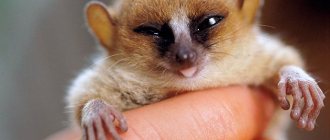Description
The marmoset or marmoset is the smallest primate on Earth. The size of an adult does not exceed 35 cm, including the long tail, which serves as a balancer for the monkey.
In 2022, using data from molecular genetic testing, several subspecies were identified from this species: the eastern pygmy marmoset, which can always be distinguished by its light underparts, and the western pygmy marmoset, which is a marmoset itself. The marmoset is distributed much further to the west than the eastern subspecies, and the main barrier for them is the Amazon and Marañon. The western one lives in the northern direction, but the eastern one lives in the southern territories.
The IUCN Red List listed the marmoset as Least Concern in 2008, and both species are now listed as Vulnerable in 2022. These tiny primates are threatened by a reduction in their habitat and deteriorating living conditions due to human activities.
Where do little monkeys live?
Small monkeys, like larger representatives of primates, mainly live in the subtropics and tropics. There are many of them in South and Central America, Africa, and the southern parts of Asia. It is there that they can feed themselves freely. It is not uncommon for monkeys to remain in the jungle for a year.
Monkeys often live in hot countries
Thus, marmosets live mainly in the upper reaches of the Amazon. They can also be found on the borders of Brazil, Colombia, Ecuador and Peru. They live in the jungle, practically never coming down from the trees. Marmosets live in Latin America. They were first discovered in Western Brazil in 1823. The habitat of the Talapoins is the forests of Gabon.
Appearance
The marmoset is the tiniest, smallest monkey. Its body and muzzle are covered with greenish-brown fur. It is interesting that each of the fur hairs has a varying degree of transition to a bright yellow shade at the tip.
The monkey's eyes are small, almond-shaped, and amber-honey in color. The primate's ears are tiny and almost invisible due to the thick fur. The marmoset has light-colored palms with disproportionately long claws that are incredibly sharp.
This restless creature weighs no more than an average apple. The average weight of a marmoset is about 100 g.
The marmoset's sharp claws and its impressive tail allow it to cling perfectly to branches while balancing between them. Light as a feather, this monkey will easily fly to the top of a tree with lush foliage, where it will not meet competitors and where its other relatives will not reach.
In addition to its tiny size, the marmoset has another unique property: it can turn its head 180%. This protects her from dangerous hunters. The nimble monkey, noticing the danger, instantly climbs onto thin branches (and, remarkably, backwards).
At the top of the tree, the marmoset is safe; neither predators nor other enemies will get there, since they will not risk being on too thin branches.
Lifestyle and habitat
The marmoset monkey is inquisitive, its nature has endowed it with active mobility, sociability and cleanliness. Animals are not seen to be aggressive. Only the encroachment of opponents into the marked territory forces the leader to take intimidating poses, frown, and twitch his ears. With its tail curved like a pipe, it signals its readiness to attack.
The dominant couple strictly raises their offspring and asserts their superiority over the young. At the same time, nothing prevents the kids from being mischievous, jumping, and playing, but they are very timid. When the family is alarmed, a loud squeal begins and they run into the scattered area.
A cluster of exotic animals has been spotted in the southern Amazon. Travelers meet them along river banks and in forest thickets. Primates love warmth. If the thermometer shows 18 degrees. - This is a harsh temperature that is difficult to survive. Although some colonies settled in the North Atlantic and arid places with unstable weather. There is no such grace that the green, rich vegetation of the jungle gives to marmosets.
Animals constantly have to monitor their safe pastime. Dwarf creatures are always in the trees, but they are afraid to climb to the top. There you can become a victim of a bird of prey. Below, their lives are threatened by wild cats and vipers.
The colony moves throughout the territory in search of food, leaning and pushing off with all its paws, jumping on trees, clinging to branches. A hole is hollowed out in the trunks with incisors, the released juices and resins are licked off. This takes most of the time, but there is also time for rest to clean the fur and rid each other of insects.
There is a clear hierarchical division of power in the marmoset family. The father controls the males, the mother controls the females. Interesting distribution of responsibilities. The newborn appears and the woman in labor is helped by all the adult members. They carry the babies on their backs while the mother is refreshed, and when the time comes, they return them to the parent.
The nature of the individuals is peaceful; fights and squabbles begin in exceptional cases. They quarrel when they have to expand the territory of individual, marked areas due to lack of food.
If you look at how the marmoset poses in the photo , you can notice its artistic abilities. And despite their miniature size, they have the instincts that nature gave to all monkeys - curiosity, interest in shiny objects. Primates communicate through emotional movements and facial expressions. They signal danger with their voices and squeals. When they return to spend the night in a hollow, they curl up comfortably there, covering themselves with their tail.
Lifestyle
These monkeys live in family groups, from a couple to 15 individuals. They are diurnal animals, and such a family begins its morning by marking its territory with loud and sharp cries. Moreover, in their arsenal there is a large number of ultra-high sounds and the human ear simply does not perceive them.
The diet of the pygmy monkey consists, for the most part, of food of plant origin: as a rule, they prefer tree sap, gum, and even resins and latex (they highly respect the “milk” of the Hevea). These are their favorite treats. Marmosets get them by gnawing the bark of a tree. But their diet also includes some fruits, seeds, flowers, nectar and mushrooms. Marmosets will not refuse insects, larvae and other animal prey, on which they spend noticeably a third of their time.
It is customary to keep marmosets as an exotic animal, but future owners are poorly aware that this fragile creature requires special care, and in a foreign environment they easily become depressed and even become aggressive.
Marmoset price
The cost of marmoset is not small. It is not available in all pet stores. The little monkey is sold privately or in big cities such as Moscow or Kyiv. Marmazetka in Kyiv costs 54,000 gr. The price of a dwarf marmoset in Moscow is from 85,000 rubles.
A white-eared marmoset costs from 75,000 to 110,000 rubles. If you have the desire and opportunity to purchase such a delight, then it will still not be so easy to buy a marmoset This is due to the fact that there are very few of them on sale.
Reproduction
These animals reach sexual maturity by 18 months, and the gestation period lasts approximately 150 days. As a result, the female gives birth to several cubs (2-3), each of which weighs no more than 25 g. The little monkeys spend the first week on their mother, clinging to her. And then, like most primates of this family, the males look after the children, carrying them on themselves and handing them over to the mother only at the time of eating. It is interesting that if the cub suddenly falls, the parents lose all interest in it.
The offspring in the group are produced exclusively by the alpha female, but all other family members (primarily the alpha male) look after the offspring. The cub is capable of independence already at the age of two to three months.
Classification of monkeys
Monkeys have been studied by scientists for a long period of time. There are a variety of classifications of mammals, the most common of which is considered to be the following:
- a group of tarsiers;
- broad-nosed primates;
- marmoset monkeys;
- callimiko mammals;
- narrow-nosed group;
- gibbons;
- orangutans;
- gorillas;
- chimpanzee.
Each group has its own bright representatives, unlike anyone else. Let's take a closer look at each of them.
Bottom line
So we found out what types of monkeys there are on the planet. Whether they are beautiful or not is up to our reader to decide. But, observing monkeys, you can see that we have a lot in common with these creatures.
This concludes our article. The editors of most-beauty.ru hope that we were able to please you with photographs and descriptions of some primates. We are waiting for your comments. Write what other beautiful species of monkeys should be on this list. We will be happy to add them.
Content
A spacious terrarium is ideal for keeping a monkey in an apartment, since these animals need to be provided with a consistently high air temperature and a certain humidity. But otherwise, these babies are unpretentious and adapt well to living conditions in captivity.
Familiarize yourself with the peculiarities of keeping such monkey breeds as capuchin and marmoset.
Requirements for a terrarium
The temperature of the terrarium should be 25-29°C, air humidity - 60%. The marmoset’s “house” must be protected from drafts. These miniature monkeys love movement, so the terrarium must have a large number of different branches and snags on which the monkeys will willingly jump.
In addition, the monkey’s habitat must have a sufficient number of shelters where it can hide if something scares it. Such secret places are very important for the psychological comfort of the animal.
Marmosets are paired animals, so if you decide to buy a marmoset, you should be prepared for the fact that you will have two pets at once. Therefore, a terrarium for a couple should be as spacious as possible: at least a meter in length and two meters in height.
Today, among pets, exotic animals are becoming increasingly popular: caecilian, tarsier, African hedgehog, land hare, mink, wombat, kea parrot, mudskipper, nose, possums, manul, lemur, striped raccoon, mini pig, cat Temminka and the mongoose.
These little ones are extremely active during the day and may suffer from lack of sunlight. Therefore, it is best to place the terrarium on the sunny side of the apartment and provide it with special lamps.
The terrarium must be cleaned at least once a month; the rest of the time, you should simply replace the contaminated soil as needed.
Important! Irregular cleaning of the terrarium can lead to the fact that marmosets will begin to mark the territory, trying to kill someone else's smell.
Behavior and lifestyle
The rhythm of life of these primates is similar to that of humans: they are active during the day and go to bed at nightfall.
While awake, they are busy jumping on branches and vines, lying in the sun and searching for food. They also spend a significant portion of their time caring for each other's fur. They live in clan groups of several generations. By nature they are shy and cautious. Despite their small size, monkeys can jump well at distances of up to a meter. You must be prepared for the fact that at first the monkeys will treat their owner with distrust. People's overreaction can frighten them, so at the beginning of your acquaintance with the marmoset you should refrain from loud sounds and sudden movements.
Feeding
In the wild, miniature monkeys eat tree sap, which they extract with their sharp teeth by gnawing on tree bark. In captivity, the diet of marmosets consists of juicy fruits (banana, melon, mango, apple) and small insects. Monkeys love natural honey nectar, as well as fresh juices. The baby's diet can be varied with baby food (without milk, so as not to cause allergies) and cereals.
To ensure your pet has strong gums, you need to give him washed dried fruits at least once a week, and bio-yogurt for comfortable digestion. Don’t forget about adding special vitamin complexes to your diet, which your veterinarian will tell you about in more detail.
Feeding a marmoset is a good way to tame it, because by accepting food from a person's hand, the marmoset begins to trust him.
Did you know? The marmoset's head can rotate 180
°
.
Care and hygiene
Caring for this funny baby comes down to regular cleaning of the terrarium, since these primates take care of all hygiene procedures on their own. Monkeys groom their own fur and do not need outside help.
In addition to monkeys, you can also have a cat, dog, fish, hamster, guinea pig or parrot in your home.
The owner of marmosets can take care of the good mood of their pets by purchasing a variety of toys for them (safe toys for children are best suited). These monkeys are inquisitive and very happy about everything new.
Reproduction
The female can have several partners, so the size of the family group can reach five individuals. The group is led by the eldest female. Marmosets can breed throughout the year, with peak births occurring from May to June and October to January.
Marmosets reach puberty at two years of age. The female carries the cub for 150 days. As a rule, marmosets give birth to no more than two babies. After they are born, all members of the group help in raising them. Males carry newborns on their shoulders and bring them to the mother for feeding.
Important! It is not recommended to take your monkey outside for walks. Foreign smells, loud noises and a large number of people will become very stressful for the baby.
Attitude towards loneliness
Marmosets are social animals; living alone is not easy for them. They can become sad, get sick and even die. Therefore, it is better to purchase primates in pairs. If this is not possible, then the owner must try with all his might to compensate for this lack of communication.
Health and prevention
In the wild, the life expectancy of marmosets is no more than 11 years; in captivity, with proper care, a monkey can live up to 20 years.
The most common disease in captive monkeys is osteodystrophy, caused by an unbalanced diet (lack of vitamin D3) and lack of adequate heat and light. In addition, errors in the diet of marmosets can cause various diseases of the oral cavity.
Exotic animals have always been interesting to humans. Read about the top 10 most popular and rare exotic pets.
At the first signs of an incipient disease (lethargy, decreased activity), you should contact a veterinarian.
Price
The average cost of a healthy individual with the appropriate documents fluctuates around 1500-2000 conventional units. Females are usually $200-300 more expensive than males.
Before getting this exotic pet, you should carefully weigh the pros and cons. Firstly, marmosets are an expensive pleasure, secondly, they require some care, thirdly, this baby is extremely active, mobile and inquisitive, fourthly, these animals can never be completely tamed, so they cannot become loyal and safe friends for household members, especially children.
In cinema
Monkeys often become heroes of feature films and TV series. Let's turn to the history of cinema to remember the films where our closest relatives starred.
King Kong
The most famous movie monkey. The first film about the monster was made in 1933. The latest film adaptation of King Kong. Skull Island" appeared in 2007. The prototype for creating the image was a large gorilla.
The animal, despite its gigantic size, is endowed with human qualities. He can empathize and falls in love with a beautiful girl.
Mr Nielsen
In the story “Pippi Longstocking” by the Swedish writer Astrid Lindgren, a nimble and funny monkey sits on the shoulder of the main character.
During the film adaptation of the story, the little monkey became one of the main characters in the children's film.
Renato
Mowgli was raised by wolves, but the hero of the Italian comedy grew up among monkeys. He understands the language of animals and has difficulty getting used to life among people.
His best friend is a chimpanzee named Renato. The smart animal helps the hero Adriano Celentano adapt to the urban jungle and even decides to escape with him to Africa.
Hero of the Striped Flight
Another chimpanzee, which causes all the commotion on the Soviet cargo ship. He didn’t have a nickname, but the sailors and captain remembered his tricks for a long time.
And she got on the ship as a gift from an African company. On the ship, she released lions and tigers from their cages, making life difficult for the crew.
?











